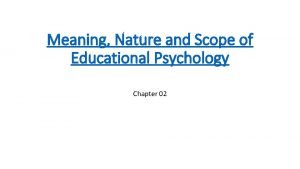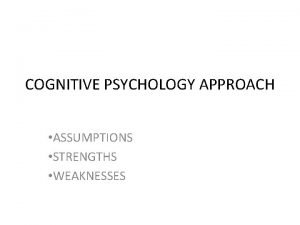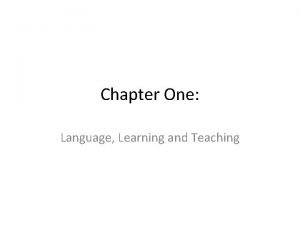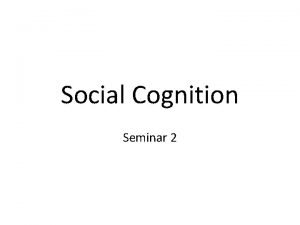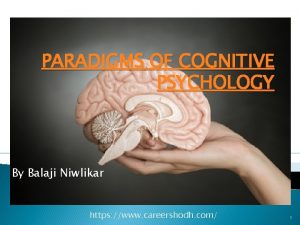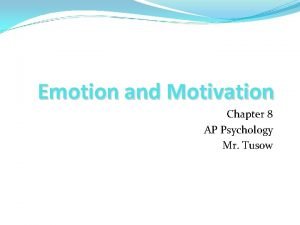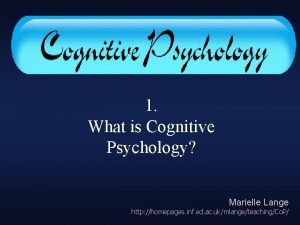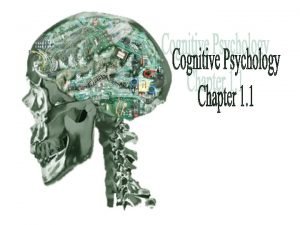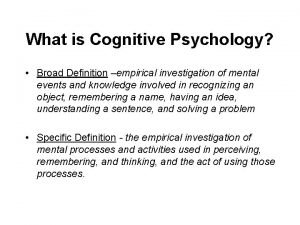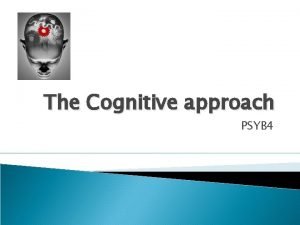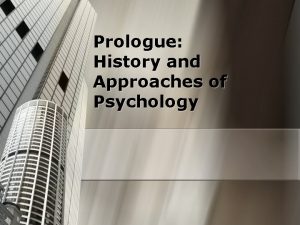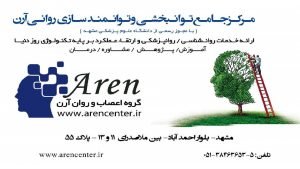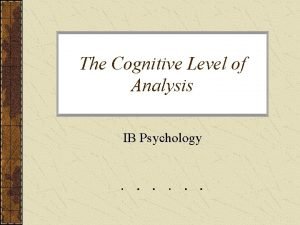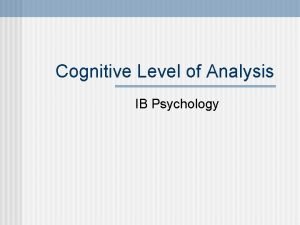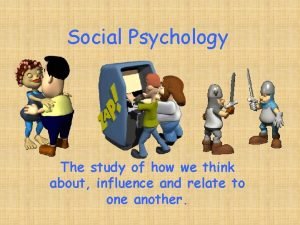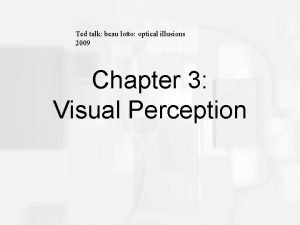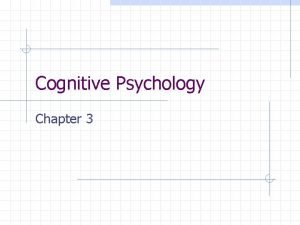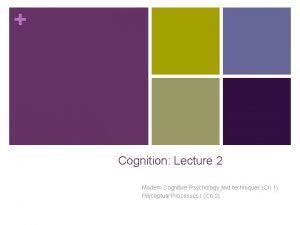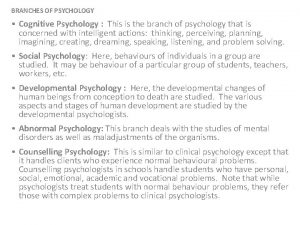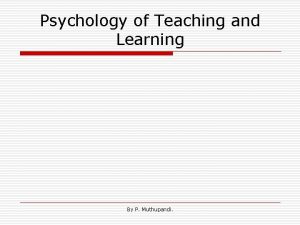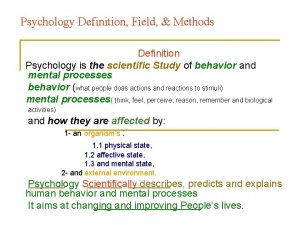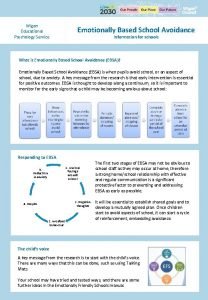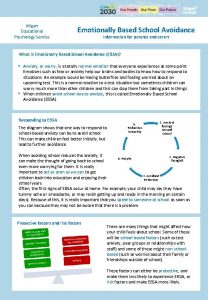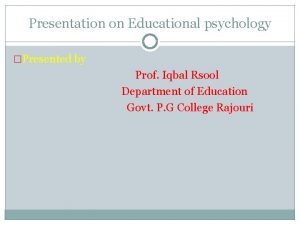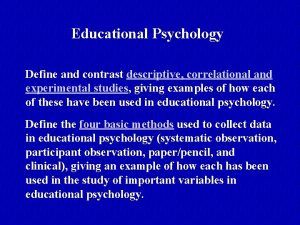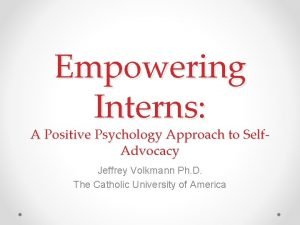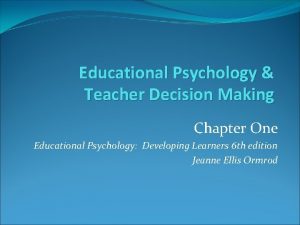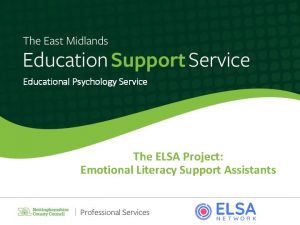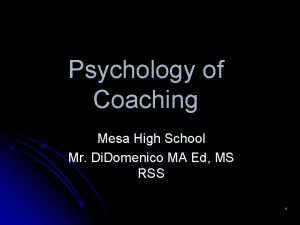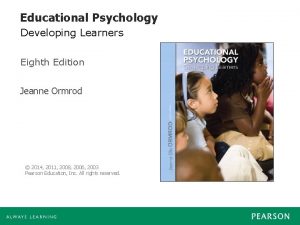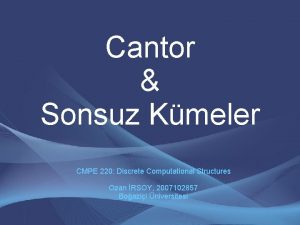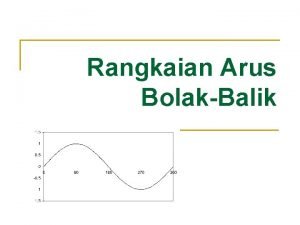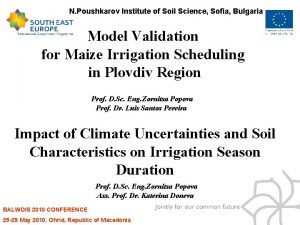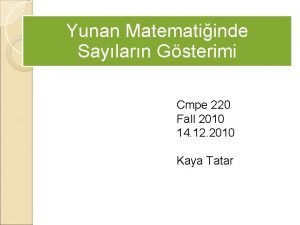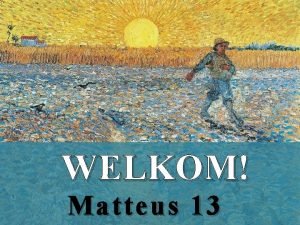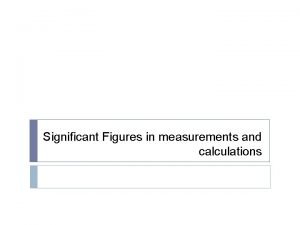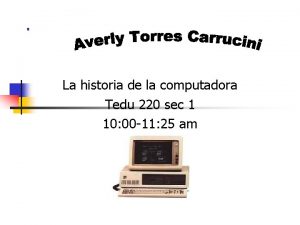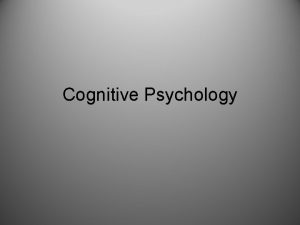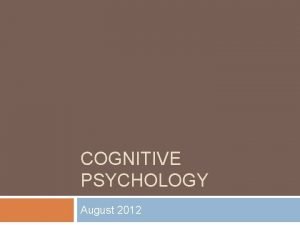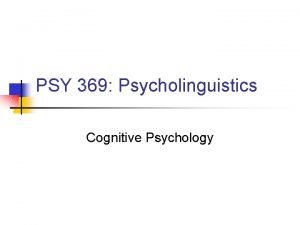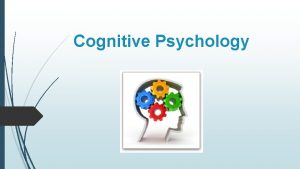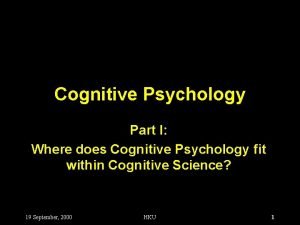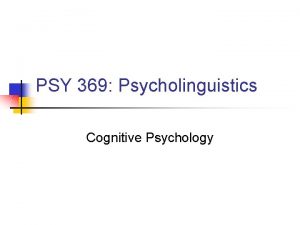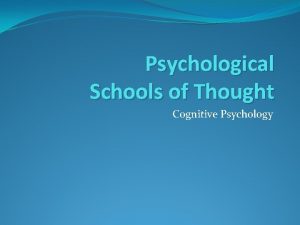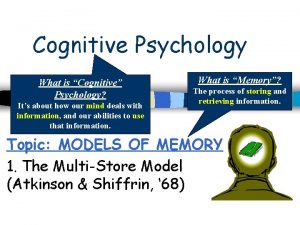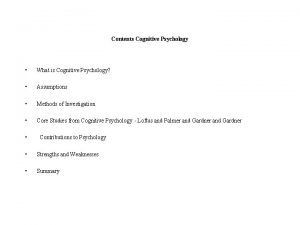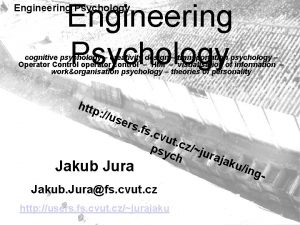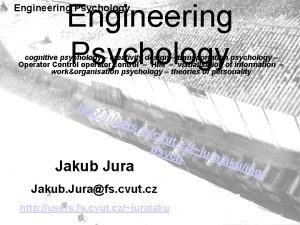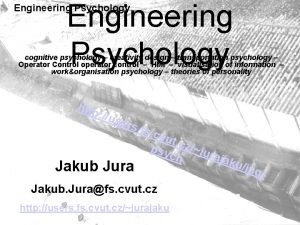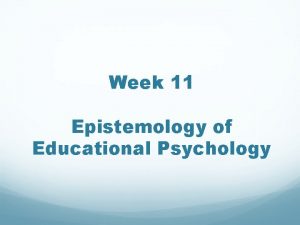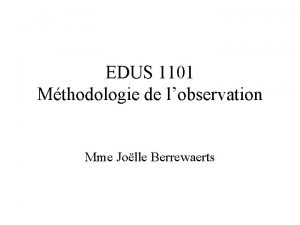EDUS 220 Educational Psychology Unit 3 Cognitive and










































































- Slides: 74

EDUS 220 Educational Psychology Unit 3: Cognitive and Social Development Dean Owen, Ph. D. , LPCC Spring 2011

How does the mind change with age and experience?

The Theory of Cognitive Development Jean Piaget “Children have real understanding only of that which they invent themselves, and each time that we try to teach them something too quickly, we keep them from reinventing it themselves. “

Topics to be discussed Brief Biography of Jean Piaget’s Theory of Cognitive Development Implications for Teaching

Jean Piaget Born: August 9, 1896 Neuchâtel, Switzerland Died: September 17, 1980 Geneva, Switzerland Swiss psychologist (Genetic Epidemiologist)

Young naturalist Jean Piaget was born on August 9, 1896, in Neuchâtel, Switzerland, the son of a historian. Much of Piaget's childhood was influenced by what he saw in his father, a man intensely dedicated to his studies and work. Because of this, at an early age Piaget began passing up recreation for studying, particularly the study of the natural sciences. When he was eleven, his notes on a rare part-albino (having extremely pale or light skin) sparrow were published, the first of hundreds of articles and over fifty books. Several times, when submitting his works to be published in various magazines, Piaget was forced to keep his young age a secret. Many editors felt that a young author had very little credibility.

Piaget's help in classifying Neuchâtel's natural-history museum collection inspired his study of mollusks (shellfish). One article, written when he was fifteen, led to a job offer at a natural history museum in Geneva, Switzerland; he declined in order to continue his education. At Neuchâtel University he finished natural science studies in 1916 and earned a doctoral degree for research on mollusks in 1918.

Early career Piaget's godfather introduced him to philosophy (the search for knowledge). Biology (the study of living organisms) was thus merged with epistemology (the study of knowledge), both basic to his later learning theories. Work in two psychological laboratories in Zurich, Switzerland, introduced him to psychoanalysis (the study of mental processes). In Paris at the Sorbonne he studied abnormal psychology (the study of mental illness), logic, and epistemology, and in 1920 with Théodore Simon in the Binet Laboratory he developed standardized reasoning tests (universal tests).

Early career Piaget's thought that these quantitative tests were too strict and saw that children's incorrect answers better revealed their qualitative thinking at various stages of development. This led to the question he would spend the rest of his life studying: How do children learn?

The study of children Piaget found four stages of mental growth while studying children, particularly his own: A sensory-motor stage, from birth to age two, A pre-operational stage, from two to seven, A concrete operational stage, from seven to eleven, and A formal operational stage from age eleven.

Piaget believed that children's understanding through at least the first three stages differed from those of adults and are based on actively exploring the environment (surroundings) rather than on language understanding. During these stages children learn naturally without punishment or reward.

Piaget saw nature (heredity, or characteristics passed down from parents) and nurture (environment) as related and equally as important, with neither being the final answer. He found children's ideas about nature neither inherited (passed down from parents) nor learned but constructed from their mental structures and experiences. Nature = Nurture

Mental growth takes place by integration, or learning higher ideas by absorbing lower-level ideas, and by substitution, or replacing early explanations of an occurrence or idea with a more reasonable explanation. Children learn in stages in an upward spiral of understanding, with the same problems attacked and solved more completely at each higher level.

Harvard psychologist Jerome Bruner (1915–) and others introduced Piaget's ideas to the United States around 1956, after his books were translated into English. The goal of American education in the late 1950 s, to teach children how to think, called for further interest in Piaget's ideas. His defined stages of when children's concepts change and mature came from experiments with children. These ideas are currently favored over the later developed stimulus-response theory (to excite in order to get response) of behavioral psychologists, who have studied animal learning. Piaget's theories developed over years. Further explanations and experiments were performed, but these refinements did not alter his basic beliefs or theories.

Process of Cognitive Development. As a biologist, Piaget was interested in how an organism adapts to its environment (Piaget described as intelligence. ) Behavior (adaptation to the environment) is controlled through mental organizations called schemes that the individual uses to represent the world and designate action. This adaptation is driven by a biological drive to obtain balance between schemes and the environment (equilibration).

Process of Cognitive Development. Piaget hypothesized that infants are born with schemes operating at birth that he called "reflexes. " In other animals, these reflexes control behavior throughout life. However, in human beings as the infant uses these reflexes to adapt to the environment, these reflexes are quickly replaced with constructed schemes.

Process of Cognitive Development. Piaget described two processes used by the individual in its attempt to adapt: assimilation and accomodation. Both of these processes are used throughout life as the person increasingly adapts to the environment in a more complex manner. Assimilation is the process of using or transforming the environment so that it can be placed in preexisting cognitive structures. Accomodation is the process of changing cognitive structures in order to accept something from the environment. Both processes are used simultaneously and alternately throughout life.

An example of assimilation would be when an infant uses a sucking schema that was developed by sucking on a small bottle when attempting to suck on a larger bottle. An example of accomodation would be when the child needs to modify a sucking schema developed by sucking on a pacifier to one that would be successful for sucking on a bottle. As schemes become increasingly more complex (i. e. , responsible for more complex behaviors) they are termed structures. As one's structures become more complex, they are organized in a hierarchical manner (i. e. , from general to specific).

The sensory-motor stage Birth to 24 months In this period (which has 6 stages), intelligence is demonstrated through motor activity without the use of symbols. Knowledge of the world is limited (but developing) because it’s based on physical interactions / experiences. Children acquire object permanence at about 7 months of age (memory). Physical development (mobility) allows the child to begin developing new intellectual abilities. Some symbolic (language) abilities are developed at the end of this stage. Object Permanence: The ability to understand that an object still exists even when it is not in sight.

Object permanence refers to the ability of the brain to retain and utilize visual images. It develops at about seven months of age. This faculty is distinct from a baby's recognition memory. For example, a baby is able to recognize and prefers to look at its mother by the third day of life. However, it will not cry upon being left by mother; "Out of sight, out of mind. " At around seven months, the child will be exhibit signs of separation anxiety when mother leaves the room. This is because the child can now appreciate what he has just lost - the presence of his mother.

Another sign of the attainment of object permanence is baby's delight at the game of "peek-a-boo, " which demonstrates graphically that the child appreciates that just because Mother is out of direct view she is still in the world and can be recalled by moving the hands or blanket out of the way.

The pre-operational Stage 2 -7 years Pre-operational stage (Toddler and Early Childhood). In this period (which has two substages), intelligence is demonstrated through the use of symbols, language use matures, and memory and imagination are developed, but thinking is done in a nonlogical, nonreversable manner. Egocentric thinking predominates There is only one way to view the world…from my vantage point. At this stage I lack the ability to appreciate events from another’s point of view. A child can hit another without realizing the pain or discomfort it may cause.

The pre-operational Stage 2 -7 years Characteristics of the Preoperational Stage: Language development is one of the hallmarks of this period. Piaget noted that children in this stage do not yet understand concrete logic, cannot mentally manipulate information, and are unable to take the point of view of other people, which he termed egocentrism. During the preoperational stage, children also become increasingly adept at using symbols, as evidenced by the increase in playing and pretending. For example, a child is able to use an object to represent something else, such as pretending a broom is a horse. Role playing also becomes important during the preoperational stage. Children often play the roles of "mommy, " "daddy, " "doctor, " and many others.

The pre-operational Stage 2 -7 years Characteristics of the Preoperational Stage: Egocentrism: Piaget used a number of creative and clever techniques to study the mental abilities of children. One of the famous techniques egocentrism involved using a three-dimensional display of a mountain scene. Children are asked to choose a picture that showed the scene they had observed. Most children are able to do this with little difficulty. Next, children are asked to select a picture showing what someone else would have observed when looking at the mountain from a different viewpoint. Invariably, children almost always choose the scene showing their own view of the mountain scene. According to Piaget, children experience this difficulty because they are unable to take on another person's perspective.

The pre-operational Stage 2 -7 years Characteristics of the Preoperational Stage: Egocentrism: Piaget’s View A B C Child’s View D

The pre-operational Stage 2 -7 years Characteristics of the Preoperational Stage: Centration: A common characteristic of the preoperational period is referred to as centration. Children seem only to be able to concentrate on one attribute of feature of a problem at a time.

The pre-operational Stage 2 -7 years Characteristics of the Preoperational Stage: Conservation: Another well-known experiment involves demonstrating a child's understanding of conservation. In one conservation experiment, equal amounts of liquid are poured into two identical containers. The liquid in one container is then poured into a different shaped cup, such as a tall and thin cup, or a short and wide cup. Children are then asked which cup holds the most liquid. Despite seeing that the liquid amounts were equal, children almost always choose the cup that appears fuller. Piaget conducted a number of similar experiments on conservation of number, length, mass, weight, volume, and quantity. Piaget found that few children showed any understanding of conservation prior to the age of five.

The pre-operational Stage 2 -7 years Characteristics of the Preoperational Stage: Conservation:

The concrete operational stage 7 -11 years • Concrete operational stage (Elementary and early adolescence). In this stage (characterized by 7 types of conservation: number, length, liquid, mass, weight, area, volume), intelligence is demonstrated through logical and systematic manipulation of symbols related to concrete objects. Characteristics of Concrete Operations: The concrete operational stage begins around age seven and continues until approximately age eleven. During this time, children gain a better understanding of mental operations. Children begin thinking logically about concrete events, but have difficulty understanding abstract or hypothetical concepts.

The concrete operational stage 7 -11 years Decentration: The ability to attend to or consider multiple aspects or features of a situation or problem simultaneously. ?

The concrete operational stage 7 -11 years Decentration: The ability to attend to or consider multiple aspects or features of a situation or problem simultaneously. : : ?

The concrete operational stage 7 -11 years Classification: The ability to systematically group, sort, and organize objects in the environment and to see patterns. Furniture

The concrete operational stage 7 -11 years Class Inclusion: Some categories are subsumed in other more inclusive categories. Are there more teddy bears or more toys?

The concrete operational stage 7 -11 years Logic: Piaget determined that children in the concrete operational stage were fairly good at the use of inductive logic. Inductive logic involves going from a specific experience to a general principle. On the other hand, children at this age have difficulty using deductive logic, which involves using a general principle to determine the outcome of a specific event. Reversibility: One of the most important developments in this stage is an understanding of reversibility, or awareness that actions can be reversed. An example of this is being able to reverse the order of relationships between mental categories. For example, a child might be able to recognize that his or her dog is a Labrador, that a Labrador is a dog, and that a dog is an animal. Animal…. Dog…. . Labrador…. . Rusty…. Labrador. …. Dog…. . Animal

The formal operational stage 11 -adult (? ) • Formal operational stage (Adolescence and adulthood). In this stage, intelligence is demonstrated through the logical use of symbols related to abstract concepts. Early in the period there is a return to egocentric thought. Only 35% of high school graduates in industrialized countries obtain formal operations; many people do not think formally during adulthood.

The formal operational stage 11 -adult (? ) The ability to think systematically about all the logical relations within a problem. Thinking about abstractions, ideals, and about the process of thinking itself (metacognition). Reality is made Secondary to Possibility Thought operates on a theoretical plane. Thinking about possibilities - what's not immediately present, not directly observed. What might occur. Abstract & Hypothetical Thought deals with propositions, no longer only objects. This is seen in: Thinking ahead - planning for the future. Thinking about hypotheses - counter factuals. Thinking about thought - metacognition. Thinking beyond conventional limits - idealism.

The formal operational stage 11 -adult (? ) IF BIRDS LIVE IN THE GROUND A GRONKER LIVES IN A TREE THEN A GRONKER IS NOT A BIRD

The formal operational stage 11 -adult (? ) Propositional Logic If x = 7, then 2 x + 4 = ___? ___ Arm: body : : Branch: __? __

The formal operational stage 11 -adult (? ) Probability and Proportional Reasoning What is the probability of drawing a blue chip from the bag…. ?

The formal operational stage 11 -adult (? ) Albert Einstein is said to have conjured his special theory of relativity by imagining himself riding on a photon traveling at the speed of light! Can you imagine what that would be like? Imagination is more important than knowledge. Albert Einstein

Huitt, W. , & Hummel, J. (2003). Piaget's theory of cognitive development. Educational Psychology Interactive. Valdosta, GA: Valdosta State University. Retrieved [date] from http: //chiron. valdosta. edu/whuitt/col/cogsys/piaget. html


Formal Operational Thought…. . Battle of Britain…. . A small lesson in history. If Germany had been successful in its plan to invade England, how would the course of WW II been different?

Lev Vygotsky believed culture was involved in cognitive development. His theory stressed the role of language and social interaction within particular cultures as being influential. He believed that children began interacting with adults or older peers on the margins of an adult activity (“legitimate peripheral participation”) – listening, watching, then helping a little, then taking on more responsibility, and finally assuming the full duty (“internalization”). What things children learn early on depends on what culture they grow up in – what is important in that society is generally taught to the young. What do we teach ours? 1896 -1934

Characteristic Piagetian Theory Development occurs in a Developmental Continuity series of distinct stages Direction of Development Role of Others Relationship of thought and language Vygotskian Ttheory Development unfolds in a continuous process devoid of set stages. Development begins with the maturation of the mind; the mind can be stimulated through social interaction and the adaptations such interactions foster Development is formed through human contacts and the verbal interactions they stimulate; the understanding derived from these interactions become internalized How children function depends largely on their level of mental maturity How children function varies greatly with the sociocultural context and the human resources present Language patterns of children are indicators of mental maturity and related thinking processes. Putting thought into words changes those thoughts, leading to deeper and richer conceptualizations.

Sigmund Freud Psychosexual Stages of Development 1856 -1939

1. Oral (birth- 18 months) 2. Anal (18 mos to 3 1/2 years) 3. Phallic (3 ½ to 6 years) 4. Latency (6 -Puberty) 5. Genital (Puberty onward)

Erickson’s 8 Ages of Man

Erikson’s Psychosocial theory Erikson’s stages are based on Freud’s in that the first five match Freud’s in time of appearance, but Erikson’s are enlarged, include more things, and there are three stages beyond. They take society more into account. The theme is search for identity and the scope is the lifespan. 1902 – 1994

Erikson 8 life Stages of Psycho-social Development Stage Period 1. trust vs. mistrust Infancy 2. autonomy vs. shame and doubt Toddler (terrible twos) 3. initiative vs. guilt Preschool years 4. industry vs. inferiority Elementary School 5. identity vs. ID confusion Adolescence 6. intimacy vs. isolation Early Adulthood 7. Generativity vs Stagnation Middle Adulthood 8. integrity vs. despair = wisdom Late Adulthood

Erikson's Eight Stages of Development 1. Learning Basic Trust Versus Basic Mistrust (Hope) Birth- 1 Year Infants either form a trusting and loving relationship with caregivers or develop a general mistrust of others and the world around them.

Erikson's Eight Stages of Development 2. Learning Autonomy Versus Shame (Will) Ages 1 -3 Young children must gain some control over their minds and bodies, for example, through walking, feeding, or dressing themselves or using the bathroom. If they succeed, with the guidance and support of others they gain a sense of autonomy. If not, they can experience persistent shame and self-doubt.

Erikson's Eight Stages of Development 3. Learning Initiative Versus Guilt (Purpose) Ages 3 -6 Children explore their independence and emerging roles through make-believe and self-initiated tasks. If caregivers are too controlling and do not encourage this self-initiative or if parental expectations for control are too high, children can experience guilt and frustration.

Erikson's Eight Stages of Development 4. Industry Versus Inferiority (Competence) Ages 6 -11 (Start of formal school) With the onset of formal education, children confront a variety of new tasks. If they succeed at these tasks through their own efforts or by cooperating with peers, children develop a sense of competence and if not, they can develop a feeling of inferiority.

Erikson's Eight Stages of Development 5. Learning Identity Versus Identity Diffusion (Fidelity) Adolescence During the fifth psychosocial crisis (adolescence, from about 13 or 14 to about 20) the child, now an adolescent, learns how to answer satisfactorily and happily the question of "Who am I? " But even the best - adjusted of adolescents experiences some role identity diffusion: most boys and probably most girls experiment with minor delinquency; rebellion flourishes; self - doubts flood the youngster. Personal values, career choices, complex social interactions….

Erikson's Eight Stages of Development 6. Learning Intimacy Versus Isolation (Love) Young Adulthood The successful young adult, for the first time, can experience true intimacy - the sort of intimacy that makes possible good marriage or a genuine and enduring friendship. Failure in this task can generate feelings of isolation and loneliness

Erikson's Eight Stages of Development 7. Learning Generativity Versus Self-Absorption (Care) Middle Adulthood In adulthood, the psychosocial crisis demands generativity, both in the sense of marriage and parenthood, and in the sense of working productively and creatively. Failure in this stage produces feelings of stagnation…of being stuck.

Erikson's Eight Stages of Development 8. Integrity Versus Despair (Wisdom) In the final stages of life, it is critical that individuals view themselves and their lives as good or satisfying…. leaving them content. If they are full of regrets or dissatisfaction, these older adults face despair instead of ego integrity. Old Age

Moral development Lawrence Kohlberg Proposed a developmental theory of moral development that progressed through three levels with two states in each level. 1927 -1987

Heinz Dilemma In Europe a woman was near death from cancer. One drug might save her, a form of radium that a druggist in the same town had recently discovered. The druggist was charging $2, 000, ten times what the drug cost to him to make. The sick woman’s husband, Heinz, went to everyone he knew to borrow the money but he could get together only about half of what it cost. He told the druggist that his wife was dying and asked him to see it cheaper or let him pay later, but the druggist said no. The husband became desperate and broke into the man’s store to steal the drug for his wife. Should the husband have done that? Why?

Moral development Lawrence Kohlberg Proposed a developmental theory of moral development that progressed through three levels with two states in each level. 1927 -1987 Pre-conventional 1 Punishment & Obedience 2 Instrumental purpose orientation Conventional 3 Interpersonal cooperation 4 Social order orientation Post-conventional 5 Social contract 6 Universal ethics

Moral development L. Kohlberg Pre-conventional Level Morality is EXTERNALLY controlled. Rules are set by authority figures and actions are judged by consequences. Stage 1 Punishment and obedience orientation The focus is fear of authority and avoidance of punishment Stage 2 Instrumental purpose orientation Become aware of different perspectives Correct actions determined by self-interest.

Moral development L. Kohlberg Conventional Level Conformity to social rules is important in maintaining social order Stage 3 Morality of interpersonal cooperation Importance of being “good” as opposed to being “bad”. Maintain approval of others by being “good”. Stage 4 Maintaining social order orientation Morality is now defined in terms of what is best for society and social order…

Moral development L. Kohlberg Post-Conventional Level Morality is defined in abstract principles that can be applied to all. Stage 5 Social Contract Orientation Laws and rules are regarded as flexible tools for enhancing human life and society. Stage 6 Universal ethical principle orientation. Correct action is defined by self-chosen ethical principles of conscience…and are valid for all regardless of law or social agreement.

Moral development L. Kohlberg Research on Kohlberg’s theory can be summarized as follows: 1. Individuals move through stages 1 -4 as predicted… 2. Moral development is slow and gradual…. 3. Reasoning in stages 1 & 2 decreases in early adolescence 4. Stage 3 reasoning increases in mid-adolescence then declines 5. Stage 4 reasoning increases during adolescence and early adulthood and becomes the typical response…. 6. Few individuals achieve stage 5 or 6 reasoning…. except for philosophers, perhaps.

Moral development Gender Differences Carol Gilligan (1982) argued that gender differences do exist and that feminine morality is more like to be based on an “ethic of care”. Little evidence for this exists in the research literature with males and females emphasizing both justice and caring about equally. However there does appear to be a difference in reasoning based on gender… Masculine Ideal: Rights and Justice Feminine Idea: Responsiveness and Care

Moral development Influences Parental Practices Schooling Peer Interaction Culture Religious beliefs and practices Individual situations (Abstract and real responses).

Moral development Culture Is each of these acts wrong? If so, how serious a violation is it? A young woman is beaten by her husband after going to a movie without his permission, despite having been warned not to do so.

Moral development Culture Is each of these acts wrong? If so, how serious a violation is it? A brother and sister decide to get married and have children

Moral development Culture Is each of these acts wrong? If so, how serious a violation is it? The day after his father died, the oldest son in the family gets a haircut and eats chicken. Source: Shweder, Mahapatra, & Miller, 1990

Moral development Culture These questions are but 3 of 39 given to Indian and American children (5 -13) as well as adults. Indian subjects rated the son’s having a haircut and eating chicken as among the MOST morally offensive acts. Beating one’s disobedient wife was not considered an offense at all. American subjects viewed each of these events in quite an opposite manner…beating one’s wife (for whatever reason) was seen as much more morally offensive than breaking arbitrary rules of mourning. Both groups found marriage between brother and sister offensive but could agree on little else in the study. Concepts of morality may be be more deeply culture bound than previously thought…. universal morality? ? ? Source: Shweder, Mahapatra, & Miller, 1990

Additional Reading In lieu of a textbook students are directed to the following sites for additional reading and information on these topics… Jean Piaget: Cognitive Development http: //www. learningandteaching. info/learning/piaget. htm Freud: Psychosexual Stages http: //wilderdom. com/personality/L 8 -5 Freud. Psychosexual. Stages. Development. html Erikson: Psycho-social Development http: //psychology. about. com/od/psychosocialtheories/a/psychosocial. htm Lawrence Kohlberg: Moral Development http: //faculty. plts. edu/gpence/html/kohlberg. htm


References Shweder, R. A. , Mahapatra, M. , & Miller, J. G. (1990). Culture and moral development. In J. W. Stigler, R. A. Shweder, & G. Herdt (Eds. ). Cultural psychology: Essays on comparative human development. Cambridge England: Cambridge University Press.
 Cognitive and non cognitive religious language
Cognitive and non cognitive religious language Explain the meaning and nature of educational psychology
Explain the meaning and nature of educational psychology Strengths and weaknesses of cognitive approach
Strengths and weaknesses of cognitive approach Generative linguistics and cognitive psychology
Generative linguistics and cognitive psychology Teaching practice chapter 1
Teaching practice chapter 1 Self fulfilling prohecy
Self fulfilling prohecy Paradigms of cognitive psychology
Paradigms of cognitive psychology Emphasis
Emphasis Yerkes dodson law ap psychology example
Yerkes dodson law ap psychology example 5 major domains of psychology
5 major domains of psychology Cognitive economy psychology definition
Cognitive economy psychology definition Computer metaphor psychology
Computer metaphor psychology History of cognitive psychology
History of cognitive psychology History of cognitive psychology
History of cognitive psychology Definition of cognitive psychology
Definition of cognitive psychology Cognitive approach definition
Cognitive approach definition Cognitive psychology crash course
Cognitive psychology crash course Cognitive model psychology
Cognitive model psychology Hamid zolfaghari
Hamid zolfaghari Discuss schema theory ib psychology
Discuss schema theory ib psychology Ib psychology cognitive level of analysis
Ib psychology cognitive level of analysis Cognitive dissonance
Cognitive dissonance Token economy psychology
Token economy psychology Cognitive psychology
Cognitive psychology Transduction cognitive psychology
Transduction cognitive psychology Cognitive psychology
Cognitive psychology Cognitive psychology branches
Cognitive psychology branches Define education according to john dewey
Define education according to john dewey Educational psychology definition
Educational psychology definition Wigan educational psychology service
Wigan educational psychology service Anita woolfolk
Anita woolfolk Emotionally based school avoidance hampshire
Emotionally based school avoidance hampshire Educational psychology conclusion
Educational psychology conclusion Define educational psychology
Define educational psychology Conclusion of educational psychology
Conclusion of educational psychology Discuss briefly the nature of educational psychology
Discuss briefly the nature of educational psychology Educational psychology
Educational psychology Educational psychology
Educational psychology Cie
Cie Educational sport psychology specialists
Educational sport psychology specialists Ormrod educational psychology
Ormrod educational psychology Social cognitive unit of personality
Social cognitive unit of personality Unit 10, unit 10 review tests, unit 10 general test
Unit 10, unit 10 review tests, unit 10 general test 220 pound to kg
220 pound to kg Decrease 220 by 15
Decrease 220 by 15 Definer 220
Definer 220 Kazutora hayashida
Kazutora hayashida Ece 220 uiuc
Ece 220 uiuc Cse 220
Cse 220 Cec 220
Cec 220 Cantor paradoksu
Cantor paradoksu 220-901 dumps
220-901 dumps 4x = 3 (mod 9)
4x = 3 (mod 9) Obliczanie stężenia procentowego
Obliczanie stężenia procentowego Smtp 220
Smtp 220 Arus
Arus Hkn review session
Hkn review session 220 280
220 280 Mhr=220-18
Mhr=220-18 Target heart rate zone
Target heart rate zone Mhr=220-16
Mhr=220-16 How to compute the thr
How to compute the thr What is maximum heart rate
What is maximum heart rate 220 280
220 280 Dl 220 2006
Dl 220 2006 Mhr=220-17
Mhr=220-17 Pbb dari 220 dan 1400
Pbb dari 220 dan 1400 Yunan harfleri
Yunan harfleri Lied 220
Lied 220 It 220
It 220 Sta 220
Sta 220 Sta 220
Sta 220 Sig fig
Sig fig 220 sec
220 sec Cps 220
Cps 220

